What Sparked the Harlem Renaissance?
The Harlem Renaissance was a cultural movement that transformed Harlem, New York, into the epicenter of Black art, literature, and music during the 1920s and 1930s. The movement didn’t arise by accident—its roots were deeply connected to larger social and historical changes in the United States. The Great Migration, which saw millions of African Americans move from the rural South to northern cities like New York, played a crucial role in setting the stage for this cultural explosion.
In the early 20th century, Harlem became a destination for Black families seeking better job opportunities and an escape from the racial violence and oppressive Jim Crow laws of the South. With its relatively affordable housing and proximity to job opportunities, Harlem became a hub for Black intellectuals, artists, musicians, and writers, creating the perfect environment for creativity to thrive. The migration brought with it a mix of African American traditions, blending them with new, urban experiences.
Another key factor was the patronage of white individuals and institutions who took an interest in Black culture. Wealthy patrons, such as Carl Van Vechten, played a role in supporting Black artists, while the establishment of venues like The Cotton Club, though segregated, gave Black performers the chance to showcase their talents to wider audiences. This fusion of social factors helped spark the Harlem Renaissance and turned Harlem into a center for Black culture.
How Did Harlem Become the Cultural Capital for Black Artists and Intellectuals?
Harlem became the cultural capital of Black America because it attracted an extraordinary mix of talented individuals who were seeking both community and creative expression. The neighborhood was buzzing with the energy of people like Langston Hughes, Zora Neale Hurston, Duke Ellington, and W.E.B. Du Bois, each of whom contributed to the flourishing arts scene in different ways. Writers, musicians, visual artists, and intellectuals found in Harlem a place to freely explore their identities and confront racial and social issues.
One of the most important aspects of the Harlem Renaissance was its focus on exploring the Black experience. Through literature, poetry, music, and visual art, Black artists were able to express their struggles, joys, and cultural pride. Langston Hughes, for example, used poetry to capture the daily lives of Black people, blending both the pain and beauty of African American life. Meanwhile, visual artists like Aaron Douglas used art to celebrate Black heritage and African roots, helping to redefine the way African Americans saw themselves.
Music, particularly jazz, played a massive role in defining Harlem’s cultural identity. Harlem’s vibrant nightlife, anchored by legendary venues like the Apollo Theater and The Cotton Club, attracted people from all walks of life. Musicians like Louis Armstrong, Duke Ellington, and Bessie Smith became household names. Jazz wasn’t just music—it was an expression of the freedom and creativity that defined the era. As Harlem’s music scene grew, it drew more attention from both Black and white audiences, further establishing the neighborhood as a cultural powerhouse.
What Legacy Did the Harlem Renaissance Leave Behind?
The Harlem Renaissance left an indelible mark on American culture, shaping not only the trajectory of Black art but also the broader national conversation about race and identity. The movement fundamentally changed the way Black Americans were represented in the arts and media, providing a powerful counter-narrative to the harmful stereotypes that had long dominated mainstream culture. By celebrating African American heritage and pushing the boundaries of creative expression, the artists and intellectuals of the Harlem Renaissance laid the groundwork for future civil rights movements.
Even after the Harlem Renaissance faded, its influence continued. The ideas and themes that were explored—racial pride, social justice, and the quest for equality—resonated with later generations of activists and artists. Many scholars argue that the Renaissance paved the way for the Civil Rights Movement of the 1950s and 60s, as it fostered a sense of pride and solidarity within the Black community. Writers like Ralph Ellison and James Baldwin, who came after the Renaissance, drew heavily on its themes, continuing the fight for Black empowerment through literature.
In the modern era, Harlem remains a vibrant cultural center. The neighborhood is still home to iconic institutions like the Schomburg Center for Research in Black Culture and continues to host events like Harlem Week, which celebrate the rich history and ongoing contributions of Black culture. The Harlem Renaissance was not just a moment in history—it was a turning point that shaped the future of Black cultural expression and left an enduring legacy that continues to inspire artists today.
The Harlem Renaissance transformed a New York neighborhood into a global symbol of Black excellence, creativity, and resilience. It provided a platform for African American artists to redefine what it meant to be Black in America, and its influence extended far beyond Harlem’s borders. The music, art, and literature produced during this era challenged racial stereotypes and sparked new conversations about race, culture, and identity.
Today, Harlem’s legacy as a cultural center continues to inspire. The Harlem Renaissance stands as a testament to the power of art to drive social change, and it remains a pivotal chapter in the story of Black America.








